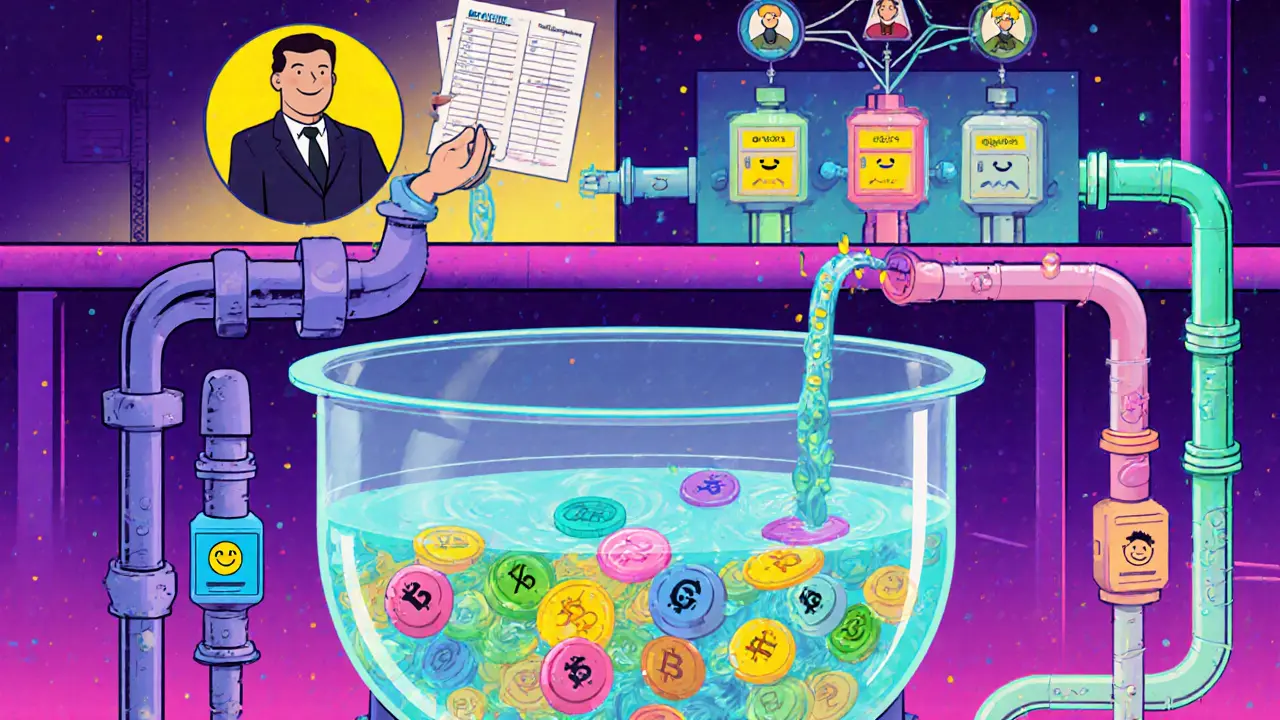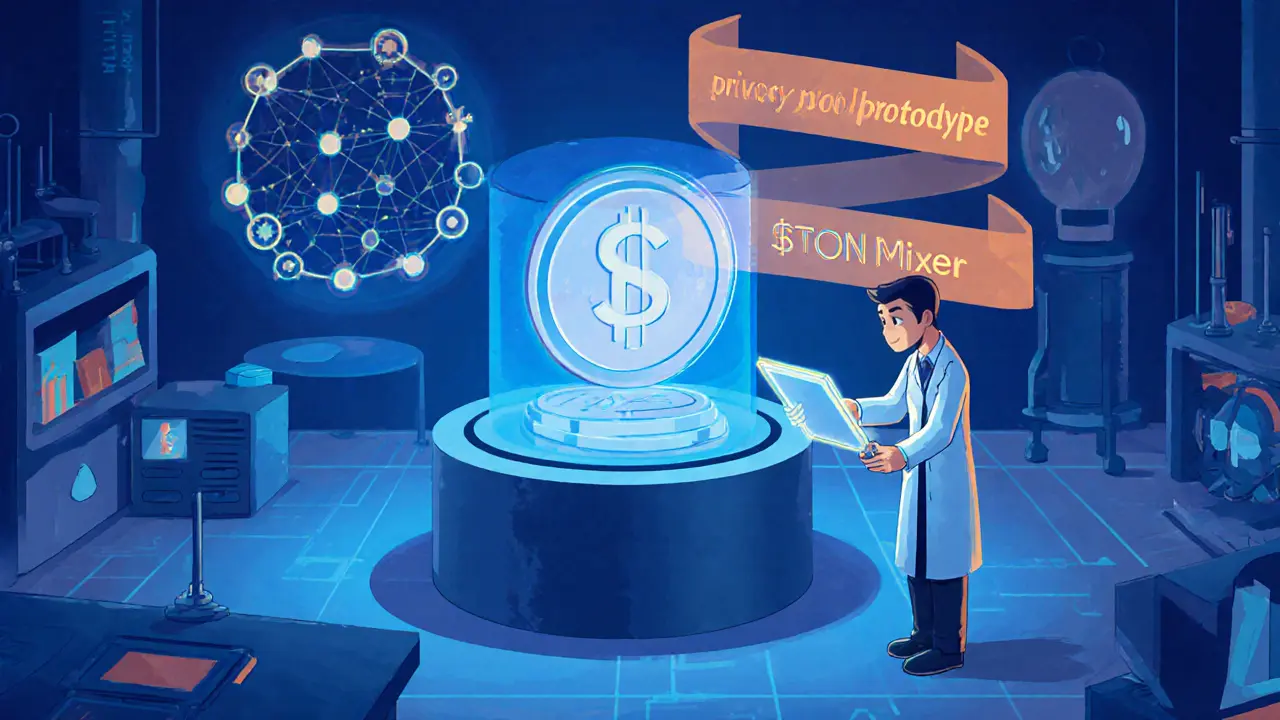 Nov, 23 2024
Nov, 23 2024
Token Verification Tool
Verify Token Legitimacy
Enter a token symbol to check if it's a legitimate cryptocurrency or a mix-up with a mixer service. Common confusion: 'MIXER' is often mistaken for a token but refers to privacy services.
Ever seen the name $TON Mixer floating around crypto forums and wondered if it’s a legit token? You’re not alone. The buzz stems from a mix‑up between a privacy‑enhancing service (a crypto mixer) and an imagined token on the TON blockchain. This article untangles the confusion, explains how mixers actually work, dives into the regulatory backdrop, and tells you whether a real $TON Mixer coin exists.
What People Mistake $TON Mixer for a Token
$TON Mixer (MIXER) is often assumed to be a native token on The Open Network (TON) blockchain, but none of the official TON Foundation docs, CoinGecko listings, or CoinMarketCap records mention such a coin. The confusion arises because the word “mixer” usually describes a privacy service, not a cryptocurrency itself.
How Cryptocurrency Mixers Work
A cryptocurrency mixer is a tool that takes deposits from many users, pools them together, and then redistributes the funds to new addresses. By shuffling the coins, mixers break the on‑chain link between the sender and the receiver, making transaction tracing much harder.
- Funds are collected in a holding pool.
- The pool is split into random batches.Withdrawals are sent to fresh addresses after a random delay.
- Service fees typically range from 1‑3% of the amount mixed.
Mixers can be centralized (run by a single entity that holds the funds) or decentralized (users collectively create a CoinJoin‑style transaction without a custodian).
Types of Mixers: Centralized vs Decentralized
Here’s a quick side‑by‑side look:
| Feature | Centralized Mixer | Decentralized Mixer (e.g., CoinJoin) |
|---|---|---|
| Control of Funds | Custodian holds user deposits. | Users retain full control; funds never leave their wallets. |
| Ease of Use | Simple web interface; low technical barrier. | Requires compatible wallet and understanding of transaction parameters. |
| Risk Profile | Counter‑party risk - service can disappear or keep logs. | Lower counter‑party risk but higher user‑error risk. |
| Typical Fees | 1‑3% per mix, sometimes a flat fee. | Usually 1‑2% plus network transaction fees. |
| Regulatory Exposure | Often targeted by AML authorities. | Harder to sanction due to lack of a central operator. |
Popular examples of centralized services include the now‑sanctioned Blender.io and Tornado Cash. Decentralized protocols like CoinJoin power mixers such as UniJoin, which currently supports Bitcoin and plans to add other assets.

Legal and Regulatory Landscape
Regulators see mixers as double‑edged swords. On one side, privacy‑advocates argue that mixers protect users in oppressive regimes. On the other, law‑enforcement agencies cite Chainalysis data showing roughly 10% of illicit crypto moves pass through mixers.
The Financial Action Task Force (FATF) updated its guidance in June 2024, demanding Virtual Asset Service Providers (VASPs) perform enhanced due diligence when dealing with known mixer addresses. In the U.S., the Treasury Department sanctioned Blender.io and Tornado Cash in July 2025, signalling a stricter stance.
Even though mixers are not illegal per se in many jurisdictions, using a mixer can trigger AML flags on exchanges. Some platforms label mixed coins as “tainted” and either refuse deposits or impose extra KYC steps.
Risks and Considerations for Users
If you’re thinking about using a mixer, keep these points in mind:
- Counter‑party risk: Centralized mixers have vanished with users’ funds - watch community reviews and audit reports.
- Technical risk: Decentralized mixers demand correct fee setting and proper withdrawal timing; a mistake can expose your transaction.
- Legal exposure: Depending on your country, mixing may breach AML laws, leading to fines or account closures.
- Liquidity: Smaller mixers might not have enough pooled funds for large amounts, causing delays or higher fees.
Reddit users often report spending 8‑12 hours learning the ropes before feeling comfortable using a decentralized service.

Is There a Real $TON Mixer Token?
Short answer: No. As of October 2025, there is no verified token named $TON Mixer on the TON network. The TON blockchain itself does not include an official privacy‑mixing protocol, though community projects like TON Privacy Pool are experimenting with CoinJoin‑style features. Until such a project matures and gets listed on reputable data aggregators, the $TON Mixer moniker remains a misnomer.
What does exist are TON‑based wallets and smart contracts that could, in theory, support mixing. But those are still in early development and not publicly available.
Bottom Line
When you hear $TON Mixer, think “privacy service on the TON network” rather than “new crypto coin.” Mixers play a genuine role in enhancing anonymity, yet they carry significant legal, financial, and technical risks. If privacy is a priority, consider reputable decentralized mixers like CoinJoin‑based tools, but stay aware of evolving regulations. And remember: there’s currently no official $TON Mixer token to buy or trade.
What is the difference between a crypto mixer and a mixing token?
A crypto mixer is a service that obscures transaction trails by pooling and reshuffling funds. A mixing token would be a tradable asset that claims to provide mixing features, but such a token does not exist for the TON blockchain.
Can I use a mixer on the TON blockchain today?
Not yet. The TON network has experimental privacy projects like TON Privacy Pool, but no fully‑launched mixer service is publicly available as of 2025.
Are centralized mixers illegal?
Legality varies by jurisdiction. In many countries they are not outright illegal but using them can trigger AML alerts and may breach local financial regulations.
How much does it cost to mix Bitcoin with UniJoin?
UniJoin charges a dynamic fee between 1% and 3% of the mixed amount, plus the usual Bitcoin network fee.
Will using a mixer protect me from law enforcement?
Mixers increase anonymity, but advanced analytics and regulatory pressure mean they are not foolproof. Law enforcement agencies have successfully traced mixed funds in many cases.
Scott McCalman
November 23, 2024 AT 06:13Yo, folks, let’s cut through the $TON Mixer hype right now 😆. People keep shouting “new token drop!” but the reality is the mix‑up comes from the privacy service, not an actual coin. The TON Foundation never listed a MIXER token, so any claim that you can trade it on an exchange is pure fiction. If you’re looking for legit utility, stick to the official TON assets. Keep your wallets safe and don’t fall for the hype train. 🚂
PRIYA KUMARI
November 24, 2024 AT 03:23This hype is pure garbage.
Jessica Pence
November 25, 2024 AT 03:00Hey everyone, just a heads up – mixers are legit tools for privacy, but they’re not tokens. You can use a service like Tornado.Cash on Ethereum, but there’s no $TON Mixer coin listed on Coingecko. Also, watch out for scams that pretend to sell you a “MIXER token” to steal your funds. Stay vigilant and double‑check any listing before you invest. Sorry for any typos, i’m typing fast!
johnny garcia
November 26, 2024 AT 00:40In summation, the nomenclature “$TON Mixer” is a semantic conflation, not an ontological token manifestation. The privacy‑enhancing service operates by aggregating deposits, re‑distributing them, thereby obfuscating provenance 📊. Consequently, regulatory scrutiny applies to the service, not to a non‑existent coin. One ought to discern between utility and tokenomics. 🧠
Andrew Smith
November 26, 2024 AT 22:03Totally agree with the points above – it’s easy to get confused. If you’re ever unsure, just check the official TON docs or reputable aggregators. Sharing knowledge helps everyone avoid scams. Keep the community strong! 🙌
Ryan Comers
November 27, 2024 AT 18:36All this “privacy service” talk is just a smokescreen. Real investors want real assets, not some nebulous mixer that only exists in rumor. If you’re patriotic about crypto, demand actual tokens that add value, not these gimmicky services. 🇺🇸💪
Prerna Sahrawat
November 28, 2024 AT 15:10While I respect the patriotic sentiment, one must acknowledge that privacy mechanisms such as mixers constitute a fundamental pillar of financial liberty. The very act of obfuscating transaction trails safeguards against unwarranted surveillance, thereby preserving individual sovereignty. Dismissing them as “gimmicks” betrays a shallow understanding of cryptographic principles. Moreover, the TON ecosystem’s architecture inherently accommodates such services without jeopardizing its core utility. In essence, the discourse should elevate beyond mere nationalism to encompass the nuanced merits of privacy‑preserving tools.
Joy Garcia
November 29, 2024 AT 11:26Sure, but don’t you think the elites are pushing these mixers to hide their own shady moves? 🤔
mike ballard
November 30, 2024 AT 08:00From a cultural standpoint, the fascination with anonymity reflects broader societal shifts toward digital self‑determination. In many regions, users gravitate toward mixers to circumvent oppressive regimes, which underscores the technology’s geopolitical relevance. The terminology “$TON Mixer” merely conflates brand identity with functional service, leading to market misunderstandings. Hence, clarity in communication is paramount to prevent misinformation. :)
Molly van der Schee
December 1, 2024 AT 04:50I totally get that perspective – clarity is key, and it’s great to see the bigger picture being discussed. Thanks for shedding light on the cultural angle.
Mike Cristobal
December 2, 2024 AT 01:40Honestly, anyone buying a “$TON Mixer” token is just throwing money into a black hole.
Erik Shear
December 2, 2024 AT 21:56Let’s stay calm and focus on facts, not hype.
Tom Glynn
December 3, 2024 AT 18:46Think of mixers as a philosophical exercise in decoupling identity from action; they challenge our assumptions about traceability. By embracing such tools, we probe the limits of transparency in digital economies. Keep exploring, and you’ll find that privacy can coexist with accountability when designed thoughtfully. 🌟
Johanna Hegewald
December 4, 2024 AT 15:20Good info, thanks for keeping it simple.
Benjamin Debrick
December 5, 2024 AT 12:26It is incumbent upon the discerning reader to recognize, with no small degree of intellectual rigor, that the very appellation “$TON Mixer” epitomizes a semantic conflation, a lexical misapprehension of profound consequence; indeed, the lexicon of cryptocurrency, replete as it is with neologisms and portmanteaus, often engenders a fertile ground for misinterpretation, a phenomenon exacerbated, dare I say, by the proclivity of market participants to indulge in hyperbolic discourse, a predilection that, in turn, begets a cascade of speculative excesses, each more labyrinthine than the last. One must, therefore, eschew the facile temptation to equate a privacy‑enhancing service with an ostensibly tradable token, for such an equation would constitute, in the parlance of classical logic, a categorical fallacy, a non‑sequitur of the highest order, and would inevitably precipitate a distortion of market signals, a perturbation of price discovery mechanisms, and, perhaps most perniciously, an erosion of investor confidence, the latter of which, as any seasoned market analyst will attest, is the sine qua non of a functional exchange ecosystem. Moreover, the regulatory landscape, a mosaic of jurisdictional statutes, mandates, and interpretative guidance, unequivocally distinguishes between service providers that facilitate anonymization and issuers of digital securities; conflating the two not only obfuscates compliance obligations but also invites undue scrutiny from supervisory authorities, who, in their prudential mandate, are ever vigilant against the specter of illicit financial flows; consequently, the erroneous narrative that a “$TON Mixer” coin circulates on recognized aggregators is, at best, a misinformed anecdote, and at worst, a conduit for fraudulent inducement, a scenario that the astute participant would, without hesitation, eschew. In summation, the scholarly imperative is clear: a rigorous demarcation must be maintained between functional utilities, such as mixers, and tokenized assets; any lapse therein would, to quote the venerable Aristotle, be “a mistake of the mind, and not of the heart,” a maxim that, in the context of contemporary digital finance, resonates with renewed urgency; thus, the sagacious investor, armed with critical inquiry and tempered by circumspection, shall navigate these waters with aplomb, steadfastly avoiding the siren call of spurious token listings, and thereby preserving the integrity of both personal portfolio and the broader crypto‑economic architecture.
Anna Kammerer
December 6, 2024 AT 09:50Wow, thank you for the doctoral dissertation on why a mixer isn’t a coin – I’ll be sure to print this and frame it above my desk. 🙄
Mike GLENN
December 7, 2024 AT 06:40I hear the frustration that many newcomers feel when they encounter the tangled web of terminology in crypto; it can be overwhelming, especially when you're trying to protect your assets and make informed decisions. It’s completely understandable to mistake a privacy service for an actual token, given how the community sometimes blurs the lines in casual conversation. The important thing is to take a step back, verify sources, and remember that not every shiny name implies a tradable coin. By fostering a supportive environment where questions are welcomed, we can collectively demystify these concepts and reduce the fear of falling prey to scams. So, keep asking, keep learning, and don’t be too hard on yourself if you get confused – we’ve all been there, and the community thrives when we lift each other up.
Sara Stewart
December 8, 2024 AT 04:53Exactly! Let’s keep the dialogue rolling and cut through the noise – no more “mixer token” myths, just clear, actionable info for everybody. 🚀